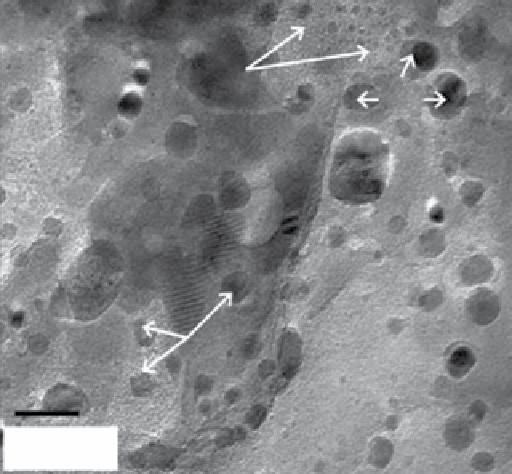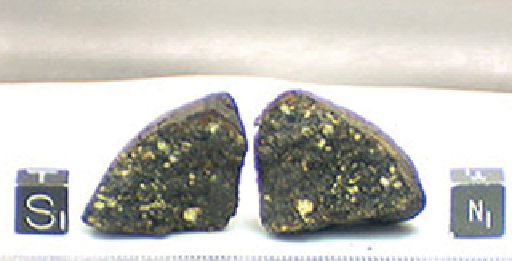Geology Reference
In-Depth Information
CR2 chondrite
43.555 g
Found December 8, 1999
4.0 × 3.0 × 2.0 cm
Weathering = Be
CR chondrites are one of the most primitive carbonaceous chondrite
groups, but they also record moderate secondary aqueous alteration.
Unusual characteristics are their high (50%-60%) content of relatively
large (0.7 mm) chondrules, high metal contents (7%-8%), and hydrated
(phyllosilicate-rich) fine-grained matrix. Most chondrules are porphyritic
types, and many chondrules have metal and sulfide rims. The matrix con-
tains a wide range of minerals such as carbonates, sulfides, and magnetite,
as well as serpentine and saponite.
QUE 99177.0
(a)
(b)
Phyllo
Sulf
Sulf
Sulf
Sulf
Amor
Sulf
Sulf
Sulf
Sulf
0.3
µ
m
30 nm
Plate 26
MiNERALogy
SigNiFiCANCE
QUE 99177 exhibits well-defined, metal-rich chondrules
up to 2 mm in diameter in a dark matrix of Feo-rich
phyllosilicate and metal. Silicates are unequilibrated;
olivines range from Fa
1-31
, with most Fa
0-2
, and pyroxenes
from Fs
1-7
Wo
1-5
. The meteorite is probably a CR2
chondrite.
The matrix of QUE 99177 is unlike many other CR2
chondrites in that it contains Feo-rich amorphus silicates
and only rare phyllosilicates and sulfides that are usually
common in matrices of CR2 (above images, [176]). in
addition, QUE 99177 contains an unusual graphite-
amphibole clast that records conditions of the primitive
solar nebula and also contains a variety of presolar grains
as in ALH 77307 and DoM 08006.
References [175-179]




